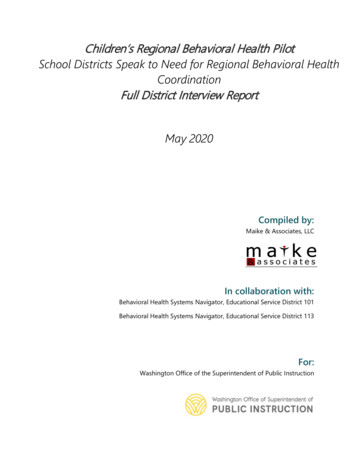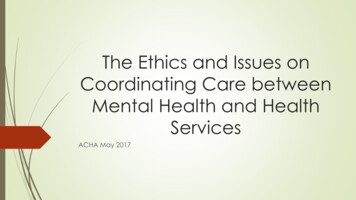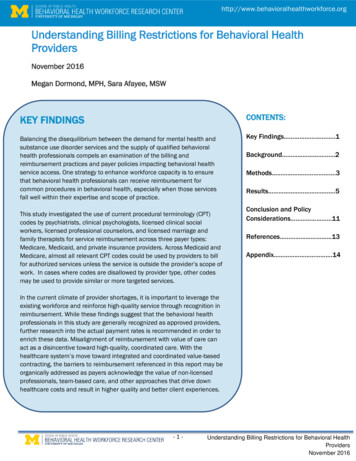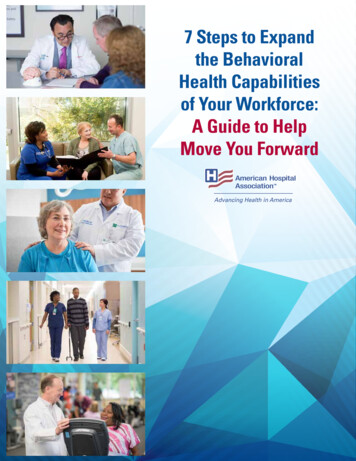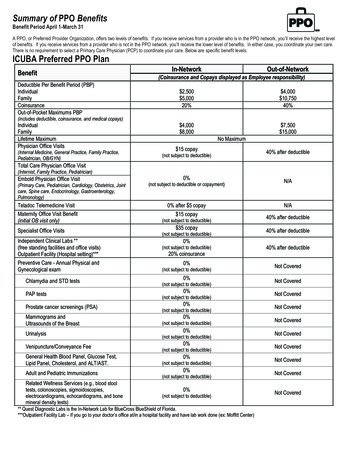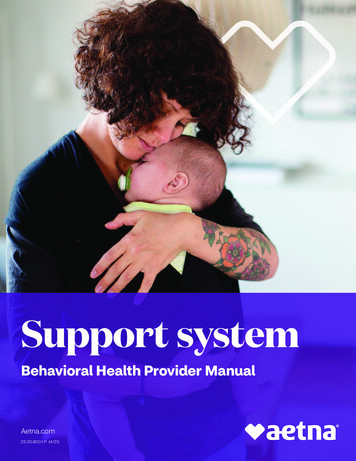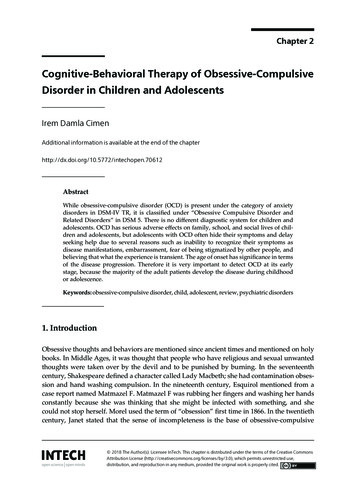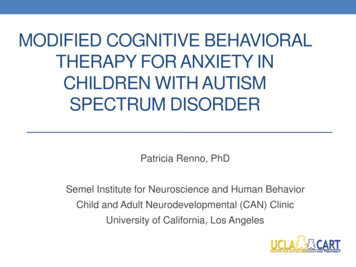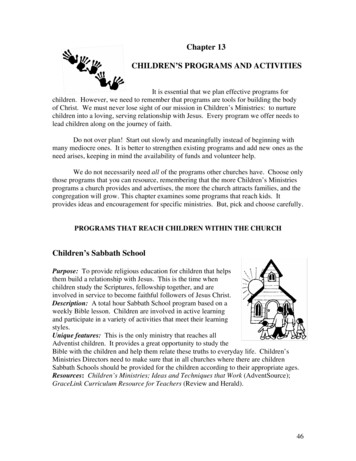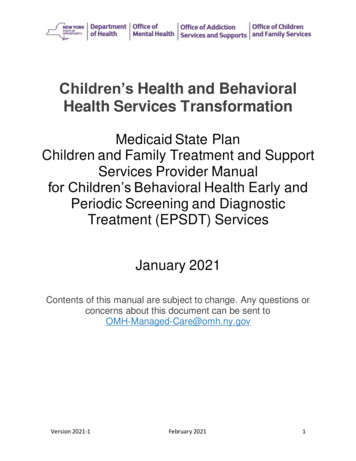
Transcription
Children’s Health and BehavioralHealth Services TransformationMedicaid State PlanChildren and Family Treatment and SupportServices Provider Manualfor Children’s Behavioral Health Early andPeriodic Screening and DiagnosticTreatment (EPSDT) ServicesJanuary 2021Contents of this manual are subject to change. Any questions orconcerns about this document can be sent toOMH-Managed-Care@omh.ny.govVersion 2021-1February 20211
Table of ContentsSection I: Background . 3Section II: Introduction . 4Section III: Services . 61. Other Licensed Practitioner . 62. Crisis Intervention . 123. Community Psychiatric Supports and Treatment . 184. Psychosocial Rehabilitation . 235. Family Peer Support Services . . 286. Youth Peer Support . 36Section IV: Medical Necessity Criteria . 45Section V: Utilization Management . 59Section VI: Standards of Care . 65Section VII: Appendices . 76A. Glossary of Terms . 76B. Knowledge Base Skills/ Recommendations. 82C. Staffing Guidelines . 83D. Cultural Competency and Language Access . 90Version 2021-1February 20212
I. BACKGROUNDNew York State (NYS) is pleased to release the Children and Family Treatment andSupport Services Provider Manual as a guide for the six children’s health andbehavioral health Medicaid State Plan services. These services are an outgrowth ofNYS’ Medicaid Redesign efforts and the valuable direction of the NYS Children’sMedicaid Redesign Subcommittee. In collaboration with the Subcommittee, the Office ofMental Health (OMH), Office of Addiction Services and Supports (OASAS), Office ofChildren and Family Services (OCFS), and the Department of Health (DOH) worked toidentify six services to benefit New York State’s children from birth up to 21 years ofage.These Children and Family Treatment and Support Services are authorized under theEarly and Periodic Screening, Diagnosis and Treatment benefits (known commonly asEPSDT). EPSDT is an array of Medicaid benefits for children under 21 years of age,which historically have been focused primarily on children’s preventive medical care(e.g., well baby visits, vaccinations, and screenings at designed ages). This set ofMedicaid State Plan services will enable a greater focus on prevention and earlyintervention by providing a greater array of available services and the capacity tointervene earlier in a child/youth’s life.The addition of these new services offers opportunities to better meet the behavioralhealth needs at earlier junctures in a child/youth’s life to prevent the onset orprogression of behavioral health conditions. This expansion of access to and range ofthese services will also help to prevent the need for more restrictive and higher intensityservices for children and youth. These following six services will be available to anychild eligible for Medicaid who meets relevant medical necessity criteria: Other Licensed Practitioner Crisis Intervention Community Psychiatric Supports & Treatment Psychosocial Rehabilitation Services Family Peer Support Services Youth Peer SupportThis array of services will allow interventions to be delivered in the home and othernatural community-based settings where children/youth and their families live. Byproviding a greater level of flexibility and the capacity for more individualized servicedelivery, NYS hopes to achieve the guiding force behind the Medicaid benefit redesign,Version 2021-1February 20213
for children and their families to receive “the right services, at the right time and in theright amount”.NOTE: An integral part of the Children’s Medicaid Redesign has been the intent toinclude the authority for and provision of State recognized Evidenced Based Practice(EBP) models. NYS continues to be committed to the promotion of support of EBPmodels under the children’s transformation and plans to develop a process foragencies to apply and be approved for the provision of recognized EBPs under theEPSDT Children and Family Treatment and Support Services State Plan services,specifically through the services of Other Licensed Practitioner and CommunityPsychiatric Supports and Treatment. This process is still under development by theState and will be issued at a later date. More information will be forthcoming.II. INTRODUCTIONThe development of the six Children and Family Treatment and Support Services StatePlan services are intended to better meet children’s needs, expand access to clinicaltreatment services, and provide a greater array of approaches for rehabilitativeinterventions. By creating these services, children and families/caregivers can morereadily access the services regardless of what “door” they may have entered. Therefore,any child who is Medicaid eligible and is identified as having a health or behavioralhealth need can access services with greater flexibility and choice.The implementation of the Children and Family Treatment and Support Services aredesigned to foster and promote the health and wellness of children/youth and theirfamilies/caregivers. As such, these services are guided by core principles inherent inthe children’s behavioral health system, known to many as the CASSP Core Principles.The CASSP (Child and Adolescent Service System Program) is based on a well-definedset of principles for behavioral health services for children and adolescents with or atrisk of developing severe emotional disorders and their families/caregivers. Theseprinciples are summarized in six core statements. Child-centered: Services are planned to meet the individual needs of the child,rather than to fit the child into an existing service. Services consider the child'sfamily and community contexts, are developmentally appropriate and child-Version 2021-1February 20214
specific, and build on the strengths of the child and family to meet the mentalhealth, social and physical needs of the child. Family-focused: The family is the primary support system for the child and it isimportant to help empower the family to advocate for themselves. The familyparticipates as a full partner in all stages of the decision-making and treatmentplanning process including implementation, monitoring and evaluation. A familymay include biological, adoptive and foster parents, siblings, grandparents, otherrelatives, and other adults who are committed to the child. Community-based: Whenever possible, services are delivered in the child'shome community, drawing on formal and informal resources to promote thechild's successful participation in the community. Community resources includenot only mental health professionals and provider agencies, but also social,religious, cultural organizations and other natural community support networks. Multi-system: Services are planned in collaboration with all the child-servingsystems involved in the child's life. Representatives from all these systems, thechild and the family collaborate to define the goals, develop a service plan,identify the necessary resources to implement the plan, provide appropriatesupport to the child and family, and evaluate progress. Culturally competent: Culture determines our worldview and provides a generaldesign for living and patterns for interpreting reality that are reflected in ourbehavior. Therefore, services that are culturally competent are provided byindividuals who have the skills to recognize and respect the behavior, ideas,attitudes, values, beliefs, customs, language, rituals, ceremonies and practicescharacteristic of a particular group of people. Least restrictive/least intrusive: Services take place in settings that are themost appropriate and natural for the child and family and are the least restrictiveand intrusive available to meet the needs of the child and family.The Children and Family Treatment and Support Services are designed to workindividually or in a coordinated, comprehensive manner, depending upon the uniqueneeds of the child/youth and family. The need for services may vary depending uponthe child’s age, developmental stage, needs of the family/caregiver, whether the childhas an identified behavioral health need, and/or the degree of the child’s complexVersion 2021-1February 20215
clinical needs. Based on these variances, children/youth can access the services invariety of ways.The utilization of the Children and Family Treatment and Support Services is intendedto be individualized to the needs of the child at any point in their development ortreatment trajectory. Therefore, a behavioral health need can be identified by multiplesources including parents and other caregivers, pediatricians, care managers,clinicians, school personnel or the young person themselves. Anyone can make areferral for services, but the determination for medical necessity must be made by alicensed practitioner.Generally speaking, a child in need can be referred for “Other Licensed Practitioner”services and “Crisis Intervention,” at which time a licensed practitioner will make adetermination for the provision of the service. For the remaining four rehabilitativeservices, which includes Community Psychiatric Supports & Treatment, PsychosocialRehabilitation Services, Family Peer Support Services, and Youth Peer Support, eachmust be recommended (see Glossary) by a Licensed Practitioner of the Healing Arts(LPHA) who determines medical necessity.III. SERVICESOTHER LICENSED PRACTITIONER (OLP)Definition:Other Licensed Practitioner (“OLP”) is a term that refers to non-physician licensedbehavioral health practitioners (“NP-LBHP’s”). NP-LBHP’s authorized under OLPinclude the following: Licensed PsychoanalystsLicensed Clinical Social WorkersLicensed Marriage and Family TherapistsLicensed Mental Health CounselorsLicensed Masters Social Workers when under the supervision of licensedclinical social workers (LCSWs), licensed psychologists, or psychiatristsLicensed Creative Arts TherapistNP-LBHP’s are licensed clinicians able to practice independently for whichreimbursement is authorized under Other Licensed Practitioner within the MedicaidState Plan. This OLP “billing authority” allows services provided by NP-LBHP’s to bereimbursable when delivered in nontraditional settings, including the home and/orVersion 2021-1February 20216
community, or other site-based settings when appropriate, as permissible under Statepractice law. Services must be within the practitioner’s scope of practice, as defined inNY State law. The delivery of services by NP-LBHP’s in these natural settings expandsthe range of treatment options for families/caregivers by allowing greater flexibility andchoice based on the needs of the child or youth. It is also expected to more effectivelyengage those children, youth and families/caregivers who may have difficulty engagingin traditional clinic-based settings.The clinical services provided under OLP are intended to help prevent the progressionof behavioral health needs through early identification and intervention and may beprovided to children/youth in need of assessment for whom behavioral health conditionshave not yet been diagnosed, including but not limited to children ages birth-5. Servicesare also intended to provide treatment for children/youth with an existing diagnosis forwhom flexible community-based treatment is needed to correct or ameliorate conditionsidentified during an assessment process, such as problems in functioning or capacity forhealthy relationships. In addition, an assessment of needs may result in therecommendation of further medically necessary services, such as rehabilitativeservices. Services are delivered in a trauma informed, culturally and linguisticallycompetent manner.Children may be referred to any agency designated to provide clinical services underOLP. Referrals may come from a variety of routine sources such as schools,pediatricians, etc., or may be a result of self-identification by a parent/caregiver or thechild/youth. Under OLP, the NP-LBHP may conduct a comprehensive clinicalassessment to diagnose, and/or determine medical necessity to develop a treatmentplan with the child/family to restore functioning and/or ameliorate behavioral healthsymptoms.In many instances, the treatment plan may also include service needs beyond thoseprovided by NP-LBHP’s and incorporate medically necessary rehabilitative State Planservices (such as those described below in this manual) to effectively address theneeds of the child/family. By recommending and including rehabilitative services, thetreatment plan serves as the mechanism to develop a comprehensive rehabilitativeservice package and to support a child and family whose needs may be complex and/orrequire flexible nontraditional approaches.Service ComponentsLicensed Evaluation (Assessment) – process of identifying a child/youth individual’sbehavioral strengths and weaknesses, problems and service needs, through theVersion 2021-1February 20217
observation and a comprehensive evaluation of the child/youth current mental, physicaland behavioral condition and history. The assessment is the basis for establishing adiagnosis where needed, and treatment plan, and is conducted within the context of thechild/youth self-identified needs, goals, and ethnic, religious and cultural identities.Assessment should result in the identification of services and practices medicallynecessary to meet the child/youth’s behavioral health needs, which may include otherSPA services.All NP-LBHP have the capacity to conduct a comprehensive assessment within thescope of their practice. NP-LBHP who have the ability to diagnose within his or herscope of practice under state law includes a Licensed Clinical Social Worker (LCSW).Licensed Master Social Workers (LMSWs) are required to work under the supervision ofa Licensed Clinical Social Worker (LCSW), licensed psychologist, or psychiatrist toconduct a diagnostic evaluation. Treatment Planning - process of describing the child/youth’s condition andservices needed for the current episode of care, detailing the scope/practices tobe provided, expected outcome, and expected frequency and duration of thetreatment for each provider. Treatment planning is part of the assessmentprocess, with the child/family’s active participation. The services identified withina treatment plan must be medically necessary to help the child/youth attain,maintain or regain functional capacity. The treatment plan should be culturallyrelevant, trauma informed, and child- and family-centered.Psychotherapy - therapeutic communication and interaction for the purpose ofalleviating symptoms or functional limitations associated with a child/youth’s diagnosedbehavioral health disorder, reversing or changing maladaptive patterns of behavior,encouraging personal growth and development, and supporting the child/youth’scapacity to achieve age–appropriate developmental milestones.Crisis Intervention Activities - If the child-youth experiences psychiatric, behavioral orsituational distress in which the NP-LBHP is contacted as the treatment provider, thereimbursement categories below allow the NB-LBHP to provide the necessaryinterventions in crisis circumstances.Crisis Triage (By telephone) - refers to activities provided by the treatingclinician through OLP which are designed to address acute distress andassociated behaviors when the child/youth’s condition requires immediateVersion 2021-1February 20218
attention due to an unplanned event that requires a rapid response. As such,crisis triage need not be anticipated in the treatment plan.Crisis Off-Site (In-person) - refers to activities provided by the treating clinicianthrough OLP which are designed to address acute distress and associatedbehaviors when the child/youth’s condition requires immediate attention due toan unplanned event that requires a rapid response. As such, crisis off-site neednot be anticipated in the treatment plan.Crisis Complex Care (Follow up) - an ancillary service to psychotherapyprovided by a clinician by telephone, with or without the child/youth. It is a clinicallevel service which may be necessary as a follow up to psychotherapy or a crisisepisode for the purpose of preventing a change in community status or as aresponse to complex conditions. It is not a stand-alone service. It is a non-routineprofessional service designed to coordinate care.Modality Individual Familyo OLP service delivery may also include family contact with or without the childpresent, as long as the contact is identified on and directly related to thechild/youth’s goals, in the treatment plan. Collateralo OLP service delivery may also include collateral contact with or without thechild present, as long as the contact is identified on and directly related to thechild/youth’s goals, in the treatment plan. Groupo Group limit refers to number of child/youth participants, regardless of payor.Groups should not exceed 8 children/youth.o Consideration may be given to smaller limit of members if participants areyounger than 8 years of age. Consideration should be given to group sizewhen family and/or collaterals are included.o Consideration for group limits, or the inclusion of an additional group clinician/facilitator, should be based on, but not limited to, the purpose/nature of thegroup, the clinical characteristics of the participants, age of participants,developmental level and severity of needs of the participants, inclusion of familyand/or collaterals in group; as well as the experience and skill of the groupclinician/facilitator.Version 2021-1February 20219
oGroups may include family/collaterals, with the child present, as long as thecontact is directly related to the child/youth’s goals and treatment planSettingServices should be offered in the setting best suited for desired outcomes, includingsite-based, home, or other community-based setting in compliance with State practicelaw.Limits and Exclusions Inpatient hospital visits by these licensed practitioners are limited to thoseordered by the child’s physician. Visits to nursing facilities are allowed forlicensed professionals other than social workers if a Preadmission Screening andResident Review (PASSR) indicates it is medically necessary treatment. Socialworker visits are included in the Nursing Facility visit and many not be billedseparately. Visits to Intermediate Care Facilities for individuals with MentalRetardation (ICF-MR) are not covered.All NP-LBHP services provided while the person is a resident of an institution forMental Disease, such as free-standing psychiatric hospital or psychiatricresidential treatment facility, are part of the Medicaid institutional service and nototherwise reimbursable by Medicaid.If a child requires medically necessary services that are best delivered in theschool setting by a community provider, the service needs to be detailed on thetreatment plan.If a child needs assistance in the schools (educationally necessary) and a schoolemployee will be providing the service, the service must be on the child’sIndividualized Education Plan (IEP) (504 plan services are not reimbursable byMedicaid).Treatment services must be a part of a treatment plan including goals andactivities necessary to correct or ameliorate conditions discovered during theinitial assessment visits.Certification/Provider QualificationsProvider Agency Qualification: Services provided under Other Licensed Practitioner (OLP) are provided byidentified non-physician behavioral health practitioners (NP-LBHP) who areVersion 2021-1February 202110
licensed by the State of New York to treat mental illness or substance usedisorder, acting within the scope of all applicable State laws and theirprofessional license. Any practitioner above must operate within a child serving agency that islicensed, certified, designated and/ or approved by OCFS, OMH, OASAS or DOHor its designee, in settings permissible by that designation. NP-LBHPs include the following practitioners; each is permitted to practiceindependently within his or her scope of practice under Title VIII of the EducationLaw and in any setting permissible under State law:(1) licensed psychoanalysts;(2) licensed clinical social workers (LCSWs);(3) licensed marriage and family therapists (LMFT);(4) licensed creative arts therapists; (LCAT); and(5) licensed mental health counselors (LMHC).(6) licensed master social workers (LMSWs) under the supervision oflicensed clinical social workers (LCSWs), licensed psychologists, orpsychiatrists. NP-LBHPs with a provisional or limited license can provide Other LicensedPractitioner services under the supervision of allowable licensed practitioners inaccordance with requirements from the New York State Education DepartmentOffice of the Professions. State recognized Evidenced-based practice (EBP) models for the purposes ofthe Children’s Medicaid transformation plan, require approval, designations andfidelity reviews on an ongoing basis as determined necessary by New YorkState.NOTE: In addition to licensure, service providers that offer addiction services mustdemonstrate competency as defined by the Department of Health, state law andregulations (14 NYCRR 853.2).NOTE: Psychiatrists, Licensed Physician Assistants, Licensed Physicians,Psychologists, and Licensed Nurse Practitioners are authorized to provide services thatare Medicaid reimbursable under a different authority within the State Plan.Version 2021-1February 202111
Training RequirementsRequired Training: Mandated ReporterRecommended Trainings: Practitioners are encouraged to review knowledge base andskills the State recommended for providers who will be delivering OLP services tochildren to demonstrate competency (See Appendix B).CRISIS INTERVENTION (CI)Definition:Crisis Intervention (CI) services are mobile services provided to children/youth underage 21 who are identified as experiencing an acute psychological/emotional changewhich results in a marked increase in personal distress and which exceeds the abilitiesand the resources of those involved (e.g., family, provider, community member) toeffectively resolve it.CI services are designed to interrupt or ameliorate the crisis experience and result inimmediate crisis resolution. The goals of CI are engagement, symptom reduction,stabilization, and restoring child/youth to a previous level of functioning or promotingcoping mechanisms within the family unit to minimize or prevent crises in the future.Mobile Crisis Intervention:Mobile Crisis Intervention is a face-to-face intervention that can occur in a variety ofsettings, including community locations where the child/youth lives, attends school,engages in services (e.g., office settings), socializes and/or works. CI services aredelivered in a person-centered, family-focused, trauma-informed, culturally andlinguistically responsive manner.CI includes engagement with the child/youth, family/caregiver and other collateralsources (e.g., school personnel) as needed, to determine level of safety, risk, and planfor the next level of services. All activities must be delivered within the context of apotential or actual behavioral health crisis with a desired outcome of diverting anemergency room visit and/or inpatient admission, when appropriate.CI services are provided through a multi-disciplinary team to enhance engagement andmeet the unique needs of the child/youth and family. Teams are encouraged to includeVersion 2021-1February 202112
a range of service providers as defined below (see: Individual Qualifications) to promotethe multi-disciplinary approach, such as, the inclusion of a Credentialed Family PeerAdvocate or Credentialed Alcoholism and Substance Abuse Counselor (CASAC). Theteam should be comprised of at least two professionals for safety purposes. Onemember of a two-person crisis intervention team must have experience with crisisintervention service delivery and be a licensed behavioral health professional:Psychiatrist, Physician, Physician Assistant, Licensed Psychoanalyst, Clinical NurseSpecialist, Addictionologist/Addiction Specialist, Licensed Clinical Social Worker(LCSW), Licensed Master Social Worker (LMSW), Licensed Mental Health Counselor(LMHC), Licensed Psychologist, Licensed Marriage and Family Therapist (LMFT), orNurse Practitioner with experience/background in treatment of mental health and/orsubstance use disorders. The team may also be comprised of non-licensed behavioralhealth professionals: Credentialed Alcoholism and Substance Abuse Counselor(CASAC), Credentialed Family Peer Advocate, Certified Recovery Peer AdvocateFamily, Certified Rehabilitation Counselor, or a Registered Professional Nurse. If onemember of the team is a Peer Advocate, the Peer Advocate must have acredential/certification as either an OMH established Family Peer Advocate Credentialor an OASAS established Certified Recovery Peer Advocate-Family .If determined through triage that only one team member is needed to respond to apsychiatric crisis, that team member must be a behavioral health professional and haveexperience with crisis intervention. If determined through triage that only one teammember is needed to respond an unlicensed Psychologist employed by state or countygovernment could respond. Similarly, a Credentialed Alcoholism and Substance AbuseCounselor (CASAC) may respond to a Substance Use Disorder crisis with a licensedbehavioral health professional available via phone. A Peer Support specialist or otherunlicensed practitioner may not respond alone, except for the CASAC as noted.Substance use should be recognized and addressed in an integrated way as it elevatesrisk and impacts both the crisis intervention being delivered and the planning forongoing care, further demonstrating the necessity of a multi-faceted team approach. Assuch, crisis services cannot be denied based upon substance use and crisis teammembers should be trained on screening for substance use disorders.Referrals for mobile Crisis Intervention services may be made through a number ofsources such as family members, school social workers, provider agencies, primarycare doctors, law enforcement, etc. Upon receiving a call/request for crisis services, apreliminary assessment of risk and mental status is conducted. The preliminaryassessment will determine if crisis services are necessary to further evaluate, resolve,and/or stabilize the crisis. This determination can be made by the following licensedpractitioners of the healing arts, operating within their scope of practice, who may orVersion 2021-1February 202113
may not be part of the crisis team: Psychiatrist, Physician, Addictionologist/AddictionSpecialist, Licensed Psychoanalyst, Registered Professional Nurse, Nurse Practitioner,Clinical Nurse Specialist, Physician Assistant, Licensed Master Social Worker (LMSW),Licensed Clinical Social Worker(LCSW), Licensed Marriage and FamilyTherapist(LMFT), Licensed Mental Health Counselor (LMHC), or a LicensedPsychologist.CI must provide 24/7/365 availability and respond within three (3) hours of thecompletion of the initial call to the crisis provider and upon the determination an inperson contact is required. A crisis intervention episode begins with the provider’s initialface-to-face contact with the child.The CI team uses methods and techniques to engage and promote symptom reductionand stabilization to restore the child/youth to a previous level of functioning. Relevantinformation is gathered from the child, family, and/or other collateral supports to assessthe risk of harm to self or others and to develop a crisis plan to address safety/mitigaterisk. The crisis plan is developed in collaboration with the child/family and should followto the extent possible, any established crisis plan already developed for the child/youthif it is known to the team.Care coordination is provided and must include at a minimum, a follow up contact eitherby phone or in person within 24 hours of the initial contact/response to assure thechild’s continued safety and confirm that linkage to needed services has taken place.Follow up may, however, include further assessment of mental status and needs,continued supportive intervention (face-to-face or by phone, as clinically indicated),coordination with collateral providers, linkage to services or other collateral contacts forup to 14 days post -contact/response. The end of the CI episode will be defined by theresolution of the crisis and alleviation of the child/youth’s acute symptoms, and/or upontransfer to the recommended level of care.Crisis Intervention services must be documented
Services Provider Manual for Children’s Behavioral Health Early and Periodic Screening and Diagnostic Treatment (EPSDT) Services January 2021 Contents of this manual are subject to change. Any questions or concerns about this document ca
